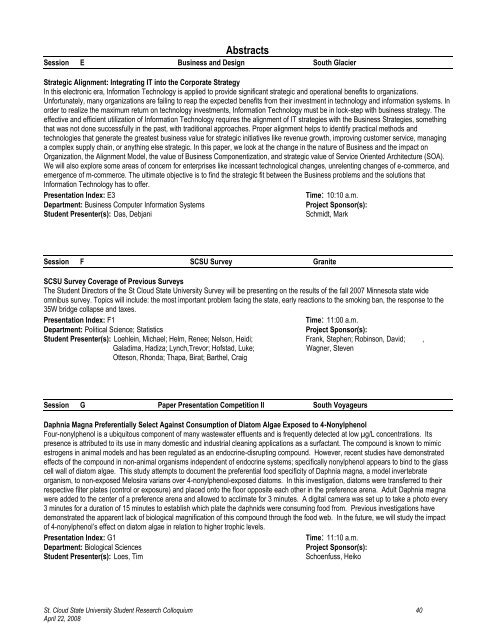2008 Proceedings - St. Cloud State University
2008 Proceedings - St. Cloud State University
2008 Proceedings - St. Cloud State University
You also want an ePaper? Increase the reach of your titles
YUMPU automatically turns print PDFs into web optimized ePapers that Google loves.
Abstracts<br />
Session E Business and Design South Glacier<br />
<strong>St</strong>rategic Alignment: Integrating IT into the Corporate <strong>St</strong>rategy<br />
In this electronic era, Information Technology is applied to provide significant strategic and operational benefits to organizations.<br />
Unfortunately, many organizations are failing to reap the expected benefits from their investment in technology and information systems. In<br />
order to realize the maximum return on technology investments, Information Technology must be in lock-step with business strategy. The<br />
effective and efficient utilization of Information Technology requires the alignment of IT strategies with the Business <strong>St</strong>rategies, something<br />
that was not done successfully in the past, with traditional approaches. Proper alignment helps to identify practical methods and<br />
technologies that generate the greatest business value for strategic initiatives like revenue growth, improving customer service, managing<br />
a complex supply chain, or anything else strategic. In this paper, we look at the change in the nature of Business and the impact on<br />
Organization, the Alignment Model, the value of Business Componentization, and strategic value of Service Oriented Architecture (SOA).<br />
We will also explore some areas of concern for enterprises like incessant technological changes, unrelenting changes of e-commerce, and<br />
emergence of m-commerce. The ultimate objective is to find the strategic fit between the Business problems and the solutions that<br />
Information Technology has to offer.<br />
Presentation Index: E3<br />
Time: 10:10 a.m.<br />
Department: Business Computer Information Systems<br />
Project Sponsor(s):<br />
<strong>St</strong>udent Presenter(s): Das, Debjani<br />
Schmidt, Mark<br />
Session F SCSU Survey Granite<br />
SCSU Survey Coverage of Previous Surveys<br />
The <strong>St</strong>udent Directors of the <strong>St</strong> <strong>Cloud</strong> <strong>St</strong>ate <strong>University</strong> Survey will be presenting on the results of the fall 2007 Minnesota state wide<br />
omnibus survey. Topics will include: the most important problem facing the state, early reactions to the smoking ban, the response to the<br />
35W bridge collapse and taxes.<br />
Presentation Index: F1<br />
Time: 11:00 a.m.<br />
Department: Political Science; <strong>St</strong>atistics<br />
Project Sponsor(s):<br />
<strong>St</strong>udent Presenter(s): Loehlein, Michael; Helm, Renee; Nelson, Heidi; Frank, <strong>St</strong>ephen; Robinson, David; ,<br />
Galadima, Hadiza; Lynch,Trevor; Hofstad, Luke;<br />
Wagner, <strong>St</strong>even<br />
Otteson, Rhonda; Thapa, Birat; Barthel, Craig<br />
Session G Paper Presentation Competition II South Voyageurs<br />
Daphnia Magna Preferentially Select Against Consumption of Diatom Algae Exposed to 4-Nonylphenol<br />
Four-nonylphenol is a ubiquitous component of many wastewater effluents and is frequently detected at low µg/L concentrations. Its<br />
presence is attributed to its use in many domestic and industrial cleaning applications as a surfactant. The compound is known to mimic<br />
estrogens in animal models and has been regulated as an endocrine-disrupting compound. However, recent studies have demonstrated<br />
effects of the compound in non-animal organisms independent of endocrine systems; specifically nonylphenol appears to bind to the glass<br />
cell wall of diatom algae. This study attempts to document the preferential food specificity of Daphnia magna, a model invertebrate<br />
organism, to non-exposed Melosira varians over 4-nonylphenol-exposed diatoms. In this investigation, diatoms were transferred to their<br />
respective filter plates (control or exposure) and placed onto the floor opposite each other in the preference arena. Adult Daphnia magna<br />
were added to the center of a preference arena and allowed to acclimate for 3 minutes. A digital camera was set up to take a photo every<br />
3 minutes for a duration of 15 minutes to establish which plate the daphnids were consuming food from. Previous investigations have<br />
demonstrated the apparent lack of biological magnification of this compound through the food web. In the future, we will study the impact<br />
of 4-nonylphenol‘s effect on diatom algae in relation to higher trophic levels.<br />
Presentation Index: G1<br />
Time: 11:10 a.m.<br />
Department: Biological Sciences<br />
Project Sponsor(s):<br />
<strong>St</strong>udent Presenter(s): Loes, Tim<br />
Schoenfuss, Heiko<br />
<strong>St</strong>. <strong>Cloud</strong> <strong>St</strong>ate <strong>University</strong> <strong>St</strong>udent Research Colloquium 40<br />
April 22, <strong>2008</strong>
















